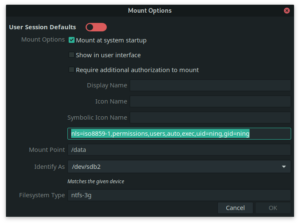

- NTFS 3G ETC FSTAB HOW TO
- NTFS 3G ETC FSTAB INSTALL
- NTFS 3G ETC FSTAB UPDATE
- NTFS 3G ETC FSTAB DRIVER
- NTFS 3G ETC FSTAB DOWNLOAD
Package ntfsprogs-2:2021.8.86_64 is already installed. Last metadata expiration check: 0:07:17 ago on Tue 07:05:51 PM EAT.
NTFS 3G ETC FSTAB INSTALL
To ensure writing to NTFS partition in Linux, install ntfsprogs package sudo dnf install ntfsprogs -y

Package ntfs-3g-2:2021.8.86_64 is already installed Step 4 : Enable NTFS support in Linux RPM Fusion for EL 8 - Free - Updates 84 kB/s | 290 kB 00:03 Safe Remi's RPM repository for Enterprise Linux 232 kB/s | 2.0 MB 00:08 Remi's Modular repository for Enterprise Linux 117 kB/s | 873 kB 00:07 Pritunl Stable Repository 119 kB/s | 548 kB 00:04 InfluxDB Repository - RHEL 12 kB/s | 34 kB 00:02 Rocky Linux 8 - PowerTools 94 kB/s | 2.2 MB 00:24Įxtra Packages for Enterprise Linux Modular 8 - 139 kB/s | 955 kB 00:06Įxtra Packages for Enterprise Linux 8 - x86_64 541 kB/s | 10 MB 00:19 Rocky Linux 8 - Extras 2.1 kB/s | 11 kB 00:05 Rocky Linux 8 - BaseOS 97 kB/s | 7.5 MB 01:19 Rocky Linux 8 - AppStream 197 kB/s | 9.1 MB 00:47 To install the package after EPEL installation, execute the command: sudo dnf -y install ntfs-3g
NTFS 3G ETC FSTAB DRIVER
Referred to as the driver in Windows Technology. This is the package that enables support for the NTFS filesystem in Linux System. Package is already installed Step 3 : Install NTFS-3G package on Rocky Linux 8 | AlmaLinux 8 sudo rpm -ivh Ĭommand output : sudo rpm -ivh
NTFS 3G ETC FSTAB DOWNLOAD
To download and install the packages in your Linux System sudo dnf install Once the extra packages are installed in your Rocky Linux, you will be able to access the storage device formatted using NTFS.
NTFS 3G ETC FSTAB UPDATE
sudo dnf -y update Step 2 : Enable EPEL repositoryĮPEL has packages that ensure NTFS is accessible in Linux systems. This is the best practice before any installation. To be able to mount an NTFS filesystem on Rocky Linux carry out the steps below. To mount NTFS on Rocky Linux 8, ensure you have the following: To be able to mount an NTFS Filesystem on Rocky Linux, you need the following Requirements for Mounting NTFS Filesystem In this article we will answer the question How a Linux system is able to access the data on a formatted device using NTFS which is a Windows Technology. NTFS (New Technology File System) is the default Windows technology for storing, organizing, and finding files on the storage device.
NTFS 3G ETC FSTAB HOW TO
With that brief background, we will now turn our attention to How to mount and unmount NTFS Filesystem on Rocky Linux 8. The default Filesystem for Linux Systems is ext4. Filesystem types include btrfs, ext3, ext4, reisersfs, ecryptfs, and swap. Linux Filesystems have the ability to create a Filesystem across multiple devices. Unmounting a Filesystem is the process of removing a mounted device from the virtual directory on a Linux System. Mounting a Filesystem can be done either manually or automatically at boot time by Linux System. Mounting a Filesystem refers to the process of adding a formatted drive partition into the virtual directory on a Linux system. Linux system uses Virtual Directory structure, which contains file paths from all the storage devices installed on the system consolidated into a single directory structure. A Linux Filesystem, therefore, shows how to locate files and directories contained within it. A Filesystem maintains a map to locate each file placed in the storage device. If you want to automount on bootup (so you don’t have to manually remount after every reboot), we need to append the following line to /etc/fstab /dev/sdb1 /media/hdd1 ntfs-3g defaults,locale=en_US.In the Linux world, Filesystems are used for managing data stored on the storage devices. Now you’re good to go! You should be able to access your external drive through the mount point you created. Now we can mount our drive point to our mount point sudo mount -t ntfs-3g /dev/sdb1 /media/hdd1 Once we have that, we need to create our mount point, this can be what or where ever you want sudo mkdir /media/hdd1 Here we want to note the drive point in our case: /dev/sdb1 /dev/sdb1 1 243201 1953512001 7 HPFS/NTFS Next, we need to find the usb drive point that we want to mount sudo fdisk -l | grep NTFS

The drive point is where the external drive will be located and the mount point is where we’d like to access it for regular usage.įirst we need to install the read/write ntfs package sudo apt-get install ntfs-3g There are two things you will need to note throughout this tutorial: drive point and mount point. This is particularly handy if you’re trying to use a Windows formatted external drive on Ubuntu. This post if for anyone looking to mount an external NTFS drive with read and write capability.


 0 kommentar(er)
0 kommentar(er)
